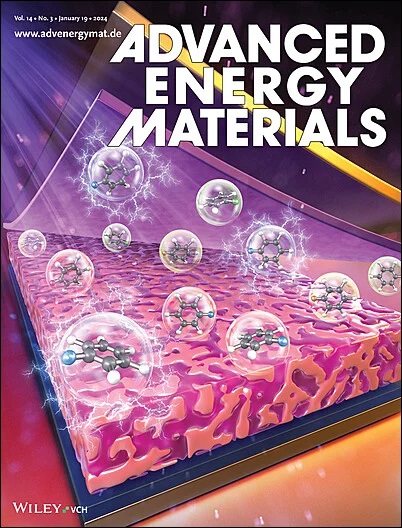固体/电解质界面中多组分磷酸盐和富晶界的协同效应促进离子向快速水锌金属电池的快速传输
IF 24.4
1区 材料科学
Q1 CHEMISTRY, PHYSICAL
引用次数: 0
摘要
快速充电水性锌(Zn)金属电池的发展对于大规模储能应用至关重要。然而,为了追求高电流密度(>10 mA cm - 2)下的快速充电能力,电解质/阳极界面Zn2+通量不平衡加剧将导致更多不受控制的枝晶生长。本文通过实验和模拟结果,提出了一个理论公式,揭示了电流密度依赖的失效机制,阐明了空间电荷诱导的Zn2+积累如何触发级联枝晶的形成。为了减轻这种动力学失配,建立了具有多组分磷酸盐和富晶界的快速离子导电固体/电解质间相(SEI)模型体系,该体系使Zn2+转移数从0.25增加到0.82,间相的迁移能垒从3.80 eV降低到1.35 eV。因此,这种设计的界面重塑使Zn||锌电池表现出超高倍率的能力和延长的耐用性(在40 mA cm - 2下达到13000次循环,在0.5 mA cm - 2下达到4000小时)。更重要的是,在2 A g−1下循环2000次后,完整的电池保持86%的容量,而工业规模的4 × 6 cm2袋状电池在100次循环后保持90.3%的容量。总的来说,这些发现通过将晶界离子动力学与有效枝晶抑制相关联,建立了高功率水性金属电池的通用界面设计原则。本文章由计算机程序翻译,如有差异,请以英文原文为准。
Synergetic Effect of Multicomponent Phosphate and Rich Grain‐Boundary in Solid/Electrolyte Interphase Boosts Rapid Ion Transport Toward Fast Aqueous Zinc Metal Batteries
The development of fast‐charging aqueous zinc (Zn) metal batteries is crucial for large‐scale energy storage applications. However, in pursuit of fast‐charging capability under a high current density (>10 mA cm−2 ), the intensified Zn2+ flux imbalance at the electrolyte/anode interphase will cause more uncontrolled dendrite growth. Herein, with experimental and simulation results, a theoretical formulation is proposed to reveal a current density‐dependent failure mechanism that elucidates how space‐charge‐induced Zn2+ accumulation triggers cascading dendrite formation. To mitigate this kinetic mismatch, a fast‐ion‐conducting solid/electrolyte interphase (SEI) model system with multicomponent phosphate and rich grain‐boundary is established, by which the Zn2+ transference number increases from 0.25 to 0.82 and the migration energy barrier at the interphase decreases from 3.80 to 1.35 eV. Consequently, this designed interfacial remodeling enables Zn||Zn cells to exhibit ultrahigh‐rate capability and extended durability (achieving 13 000 cycles at 40 mA cm−2 and 4000 h at 0.5 mA cm−2 ). More significantly, full cells retain 86% capacity after 2000 cycles at 2 A g−1 , while industrial‐scale 4 × 6 cm2 pouch cells maintain 90.3% capacity over 100 cycles. Collectively, these findings establish a universal interfacial design principle for high‐power aqueous metal batteries by correlating grain‐boundary ion dynamics with effective dendrite suppression.
求助全文
通过发布文献求助,成功后即可免费获取论文全文。
去求助
来源期刊

Advanced Energy Materials
CHEMISTRY, PHYSICAL-ENERGY & FUELS
CiteScore
41.90
自引率
4.00%
发文量
889
审稿时长
1.4 months
期刊介绍:
Established in 2011, Advanced Energy Materials is an international, interdisciplinary, English-language journal that focuses on materials used in energy harvesting, conversion, and storage. It is regarded as a top-quality journal alongside Advanced Materials, Advanced Functional Materials, and Small.
With a 2022 Impact Factor of 27.8, Advanced Energy Materials is considered a prime source for the best energy-related research. The journal covers a wide range of topics in energy-related research, including organic and inorganic photovoltaics, batteries and supercapacitors, fuel cells, hydrogen generation and storage, thermoelectrics, water splitting and photocatalysis, solar fuels and thermosolar power, magnetocalorics, and piezoelectronics.
The readership of Advanced Energy Materials includes materials scientists, chemists, physicists, and engineers in both academia and industry. The journal is indexed in various databases and collections, such as Advanced Technologies & Aerospace Database, FIZ Karlsruhe, INSPEC (IET), Science Citation Index Expanded, Technology Collection, and Web of Science, among others.
 求助内容:
求助内容: 应助结果提醒方式:
应助结果提醒方式:


